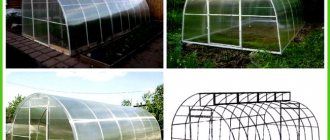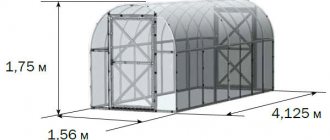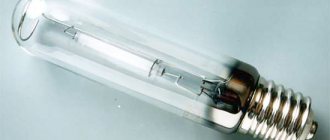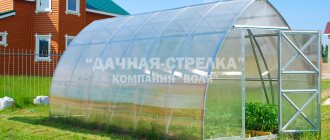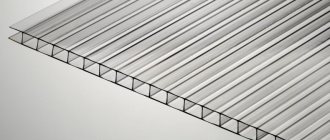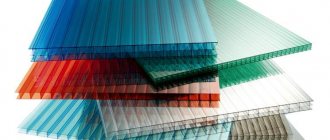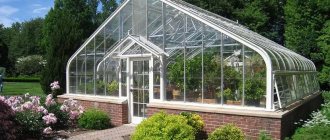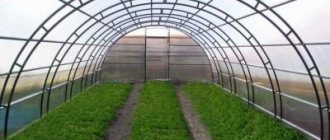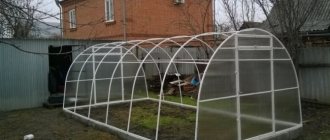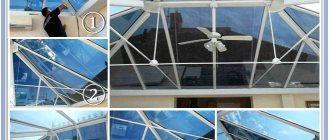Short story
Plastic obtained from polymer raw materials, that is, polycarbonate, was produced in Germany and the USA back in the 50s of the last century.
Its industrial production began a decade later, but honeycomb sheets first appeared only in the 80s in Israel. Due to its unique characteristics and useful properties, polycarbonate quickly gained popularity and became widespread. It is used in a variety of areas, but if we talk about personal farms, then this material has become the main one in the manufacture of greenhouses.
Types of polycarbonate
Several types of polycarbonate are used for the construction of greenhouses:
- Monolithic - a transparent solid sheet with a smooth surface.
- Cellular - has a structure with hollow cells and partitions between them.
- Profiled - the surface of the sheet is corrugated, wavy or corrugated.
The release form of standard polycarbonate is a sheet of certain sizes. According to reviews from experienced summer residents, the best polycarbonate for making greenhouses is cellular. It retains heat well due to its cellular structure and has the necessary rigidity to withstand wind and snow.
Which polycarbonate is better for a greenhouse - cellular or monolithic?
The functional purpose of the greenhouse is to create an optimal combination of temperature and moisture when growing various agricultural products. In this case we are talking about quite large volumes, therefore the areas occupied by greenhouses are very large. This imposes some restrictions during construction, for example, regarding the materials used, the specific gravity of which cannot be large. Otherwise, you will have to solve the problem of installing a heavy and solid frame, which will significantly increase the owner’s expenses. Based on the above, the best option is cellular polycarbonate, which has a hollow structure. If we compare it with a monolithic one, then, with the same sheet thickness, it has a lower specific gravity. Another argument in favor of cellular polycarbonate is its low thermal conductivity due to its hollow structure.
Types of plastic for greenhouses
Before answering the main question: polycarbonate greenhouses, how to choose polycarbonate, let’s look at the types of this modern material on the market.
Based on their structure, they distinguish between monolithic and cellular (cellular) polycarbonate. Monolithic, as the name implies, are solid sheets of various thicknesses and sizes. Using thermoforming, they can take any shape, which is very convenient when building complex structures.
The strength of monolithic materials is higher than that of cellular materials. They can be used for floors without additional frames. Available in a variety of colors, as well as in the form of transparent colorless sheets. Monolithic plastic can be used for greenhouses, but it is quite expensive.
The optimal choice for our purposes is cellular polycarbonate. It is lightweight, transmits light well, and has a special coating to protect against ultraviolet rays.
The air gap that fills the space of the cells increases the heat-shielding properties, which is of great importance for greenhouse structures.
Separately, it is necessary to say about
lightweight grades of polycarbonate. It is manufactured with thinner external and internal partitions, which saves raw materials and reduces its cost, but the performance characteristics do not benefit from this.
The only plus is the affordable price . Used for temporary greenhouses, as a worthy replacement for film covering.
The market offers products from domestic and imported manufacturers.
Of the Russian brands, the generally recognized leaders are “ROYALPLAST”, “Sellex” and “Karat”, which produce high-grade quality material. Companies such as Polynex and Novattro have proven themselves to be excellent.
Polycarbonate brands Ekoplast and Kinplast specialize in producing cheaper, lightweight modifications. A distinctive feature of carbonates from Russian producers is that they are better adapted to our weather conditions.
The main competitor of our manufacturers is China, whose products are not of high quality, but are affordable.
Polycarbonate from European manufacturers is of the highest quality. Its price exceeds the average market offer.
What thickness of polycarbonate is best to use for a greenhouse?
| Sheet thickness, mm | Sheet width, mm | Distance between ribs, mm | Minimum permissible bending radius, mm | Factor U |
| 4 | 2100 | 5,7 | 700 | 3,9 |
| 6 | 2100 | 5,7 | 1050 | 3,7 |
| 8 | 2100 | 11 | 1400 | 3,4 |
| 10 | 2100 | 11 | 1750 | 3,1 |
| 16 | 2100 | 20 | 2800 | 2,4 |
This aspect is of great importance, not only from the point of view of the level of upcoming costs, but also the efficiency of using the greenhouse. When thinking about what thickness you need to choose polycarbonate for a greenhouse, you should rely on the following factors:
- sheathing pitch dimensions;
- geometric shape of the greenhouse, slopes and angles in the structure;
- snow load inherent in the region;
- temperature regime;
- what crops will be grown in the greenhouse.
As quite often happens, the customer is inclined to the cheapest option, in which the sheets are inexpensive and have a minimum thickness. The benefit obtained in this option is deceptive, since such a structure will have insufficient strength and its frame will have to be strengthened. This is the only way to compensate for the lack of strength under snow or wind loads.
However, you should also not automatically select the thickest sheets, because in this case the light transmission will suffer, and the frame will again have to be strengthened due to the large specific weight of the structure.
In most situations, the optimal thickness of polycarbonate sheets is in the range from 4 to 10 millimeters. The sheathing pitch is recommended within the range of 700-1015 millimeters, this will reduce the consumption of the material used without loss of quality and reliability.
Important to know: It is important to take into account the shape of the greenhouse in this aspect; when using arched options, the thickness of the sheets is directly related to the bending radius of the material. For pitched greenhouses, the situation is also ambiguous; often thin sheets of 4 millimeters are chosen for their walls, but for roofs they take options of 6 or even 10 millimeters.
Finally, if early vegetables are grown in a greenhouse, then profiles 4 millimeters thick will be the optimal solution, but for seedlings you should select a thicker option, at least 6 millimeters.
How to choose high-quality polycarbonate for a greenhouse
So, knowing all the characteristics of polycarbonate, before purchasing you need to decide which one to choose for building a greenhouse. Reinforced sheets are useful for permanent structures in regions with difficult weather conditions, where vegetables will be grown all year round. Such a PC must withstand snow loads. In other areas, you can choose simpler and cheaper options.
You can measure the thickness of the purchased sheet using a caliper. If there are deviations from the standards, then it is better to refrain from purchasing such a PC. Its quality is questionable.
The presence of ultraviolet protection can be determined not only in documents. The thin protective film contains markings indicating which side of the PC will face the sun.
To make a greenhouse you need to buy the best cellular polycarbonate. After all, cheap materials are produced from recycled materials or with manufacturing irregularities. They will not make a quality greenhouse. The service life of PC sheets is no more than 2-5 years.
It is important to understand that little-known companies that no one on the market has heard of are unlikely to offer anything worthwhile. It is better to choose polycarbonate from well-known brands for the greenhouse. They are interested in their reputation.
What color of polycarbonate is better to choose for a greenhouse?
Manufacturers present either painted panels or completely transparent ones to the attention of buyers. Greenhouse owners make their choice based on various factors, but two of them should play the main role:
- Light transmission should be maximum.
- The lighting inside the greenhouse should be as close to natural light as possible.
Transparent panels demonstrate the highest light transmittance; it is approximately 80%. If you still want to use certain colors, then you should remember that some of them have too much light absorption. For example, panels of the popular and fashionable bronze shade can absorb up to 60% of sunlight, which can cause irreparable damage to the plants being grown.
Color and honeycomb matter
When choosing cellular polycarbonate, you should pay attention to its structure - it also has a significant impact on its strength, light transmittance and overall quality.
On a note! In fact, the honeycomb present in the structure of the material is very important. The fact is that they create an air gap, which allows the greenhouse to retain heat much better.
There are three types of honeycombs.
- Rectangular . The type of polycarbonate with such honeycombs is used most often. This polycarbonate has low strength, but at the same time it transmits light well and is perfect for creating small greenhouses.
Polycarbonate with rectangular honeycomb
- Square . Polycarbonate with this type of honeycomb is stronger than the previous type. Typically used for fairly large structures.
- Hexagonal . Material having honeycombs of this shape is the strongest and is not afraid of winds and snowfalls. But it transmits light much worse. Typically used in the construction of roofs, it is rarely used as a covering for greenhouses.
Square Honeycomb Polycarbonate
Cellular polycarbonate with hexagonal cells (top)
In order not to spend extra money, it is worth clearly weighing all the requirements for the future structure. There is no point in installing a polycarbonate greenhouse with hexagonal honeycombs in a warm and windless region - these will be unjustified costs. And such material transmits light less well, which means it is not suitable for plants, especially light-loving ones, so you will have to spend money on additional lighting.
The color of cellular polycarbonate is also of great importance. In pursuit of fashion, manufacturers now offer material in almost any color - not only yellow, green, red, but even black. But when choosing polycarbonate by color, you should first of all think not about the design, but about the plants that will live in the greenhouse. It is worth carefully familiarizing yourself with the light transmittance of each type, and the lighting should be as close as possible to the natural level - only in this case will the representatives of the flora in the greenhouse be comfortable.
Types and colors of polycarbonate
Attention! The light transmission of polycarbonate for plants must be at least 80%.
Not all colored sheets meet this requirement. For example, blue polycarbonate absorbs 40% of solar radiation, and bronze – all 60%. It is also worth remembering that colored polycarbonate often transmits only a certain part of the spectrum, and there is no guarantee that it will only block the type of radiation that is dangerous to plants.
Light transmission of cellular polycarbonate
Based on the above, we can conclude that the optimal polycarbonate should be transparent and have a square honeycomb. This will be the optimal solution in combination with a material thickness of 8 mm.
Polycarbonate with and without UV protection
Prolonged exposure to ultraviolet radiation on transparent polycarbonate can lead to destruction and the formation of cracks on its surface. At first they appear in a microscopic form, but then they grow and ultimately lead to a decrease in the strength of the panels and their breakage. For protection, manufacturers use a special protective coating applied to the outer layer of the panels.
In most cases, such a layer is present only on one side, but some types of polycarbonate contain it on both sides. They are not used for the construction of greenhouses; their scope of application is, for example, outdoor advertising structures exposed to ultraviolet radiation on both sides.
There are options without such a layer, but such polycarbonate should not be used for outdoor work. It is needed for interior work, otherwise destructive processes will render it unusable in a short period of time, no more than a year.
Feedstock for polycarbonate
Polycarbonate for greenhouses is a plastic polymer that is in granules, but after processing it takes on its final form. In addition to the granules themselves, the raw materials include:
- carbonic acid;
- solvents;
- diatomic phenol;
- water.
As a result of the processing and synthesis of phenol, polycarbonate is obtained. In its natural form it is transparent or has a slightly yellow tint. In order to obtain colored polycarbonate, dyes are added to the raw material.
Important! In manufacturing, the term "polycarbonate" is shortened to PC or PC.
Comparative characteristics of popular polycarbonate manufacturers
| Specifications | Unit change | Manufacturer and brand | |||
| SafPlast Novattro | Bayer Makrolon | Polygal | PlastiLux Sunnex | ||
| Distance between ribs | mm | 6 | 6 | 5,8 | 5,7 |
| Specific gravity | kg/m2 | 0,75 | 0,8 | 0,65 | 0,79 |
| Light transmittance | % | 84-87 | 81 | 82 | 86 |
| Minimum bend radius | mm | 700 | 750 | 800 | 700 |
| Heat transfer resistance | M2°C/W | 5,8 | 4,6 | 2,56 | 3,9 |
Today, the Russian market is distinguished by a wealth of choice among manufacturers of various levels. The most famous of them are SafPlast Innovative, Bayer material science, Poligral or PlastiLux. The products of these manufacturers are approximately comparable in terms of quality and price; the choice is largely related to customer preferences.
If we analyze the reviews of consumers who have purchased products from various polycarbonate manufacturers, and not only Russian ones, we can draw a number of conclusions:
- panels of the Sunnex brand, popular in our country, last no more than 4 years, although the manufacturer claims 7-8 years of operation;
- Poligral products, provided the panels are installed correctly, can last for 10 years;
- SafPlast Innovative panels are slightly inferior in this regard, but they can also last at least 8 years;
- Makrolon panels, which have the longest service life - 12 years, have proven themselves best.
Design and main characteristics of cellular polycarbonate
The unique properties of cellular polycarbonate are determined by two main factors: the cellular structure and the chemical composition of the material. This type of polycarbonate is a multilayer panel with transverse partitions that ensure its sufficient strength and rigidity. The honeycombs in the cross section of the sheet can have a rectangular or triangular shape in different combinations.
The total number of layers in the material can be from two to four, depending on its thickness and type.
The main technical characteristics of the most common types of cellular polycarbonate are presented in the table:
| Sheet thickness, mm | 4 | 6 | 8 | 10 | 16 | 20 | 25 |
| Panel length and width, mm | 6000 (12000)×2100 | ||||||
| Specific gravity of material, kg/m2 | 0,8 | 1,3 | 1,5 | 1,7 | 2,7 | 3,0 | 3,5 |
| Thermal conductivity of the sheet, m2×°C/W | 0,24 | 0,27 | 0,28 | 0,29 | 0,42 | 0,56 | 0,68 |
| Light transmission,% | 83 | 82 | 82 | 80 | 76 | 51 | 58 |
| Minimum sheet bending radius, m | 0,7 | 1,05 | 1,5 | 1,75 | 2,8 | 3,5 | 4,4 |
| Change in properties during artificial aging of the material, arb. years | 10 | 20 | 30 | ||||
Analysis of the data given in the table allows us to draw some conclusions that facilitate the process of selecting material for greenhouses.
The most significant characteristics for cellular polycarbonates used in the construction of greenhouses are the following:
- light transmission;
- thermal resistance to heat transfer;
- specific gravity;
- mechanical strength;
- life time.
A simple comparison of parameters for different types of panels allows us to unambiguously determine the direct dependence of the listed characteristics on the thickness of the sheet. Based on the results of this study, we can conclude that the performance characteristics of this material will directly depend on this parameter.
What is Light polycarbonate?
When choosing polycarbonate, you may encounter the Light or “eco” marking. Hidden underneath is an economy-class product that costs less than others; naturally, you shouldn’t count on high quality in this case.
This lightweight version of polycarbonate is obtained due to some solutions, in particular, manufacturers can reduce the thickness of the sheets from 4 to 3.5 millimeters, or specific density. Such solutions reduce the cost, but at the same time lead to a decrease in the strength of the material. Such structures cannot be used for winter construction, since the service life will be shorter, and heating costs will make such a solution completely ineffective. But for summer greenhouses or greenhouses this option is very suitable.
Pros and cons of polycarbonate for greenhouses
Polycarbonate used for the construction of greenhouses has many advantages. In addition to its good ability to transmit light, due to its transparency it is light in weight and has a number of other advantages:
- excellent ability to retain heat;
- good gas permeability;
- high flexibility, raw materials suitable for creating arched structures;
- long service life, more than 10 years;
- high strength, some monolithic types are bulletproof;
- good resistance to mechanical damage.
In addition, polycarbonate for greenhouses retains ultraviolet rays and does not lose its properties at high temperatures, even if its surface is heated to +60°C. The raw materials are completely environmentally friendly and have low cost.
However, polycarbonate also has disadvantages. Raw materials are unstable to chemicals and deteriorate when exposed to ethyl alcohol, varnishes, kerosene or gasoline, ammonia, and all kinds of solvents. With prolonged contact with the listed substances, cracks appear and the sheets become deformed. That is why it is necessary to take care of such coating in greenhouses very carefully.
Warning! All cleaning products must not contain aggressive chemical compounds.
DIY installation rules
There are no particular difficulties in installing polycarbonate panels, but only if the following rules are followed:
- Layout of sheets. The panels must be positioned so that the internal stiffeners are in a vertical position. If we are talking about roof slopes, then these ribs should be positioned along and at an angle relative to the slope. Thanks to this solution, condensate will flow down without difficulty.
- On arched structures, the long side of the panels is thrown over the arch and all joints and fastenings must be sealed.
- Sheets of small thickness can be cut with a construction knife; for thicker ones, you should use a hacksaw or a fine-toothed saw. The mounting holes are made with a drill or crown at a distance of 40-50 millimeters from the edges.
- The panels are laid at the installation site using thermal washers and always with the protective side up. There is no need to tighten the screws too much; this will damage the profiles in the future. The ends are sealed, the joints are connected with a special profile, and punched tape is used for arches.
Recommendations from experts
It is important to take into account the recommendations of professionals involved in the installation of greenhouses and laying polycarbonate sheets. This will ensure maximum effect from the erected structure, which will last for many years.
Basic Rules:
- Say no to thick plastic. Thick sheets help reduce light transmittance and increase the overall weight of the structure. At the same time, thick products improve thermal insulation and increase strength. To use such materials, you will need a high-strength structure. If you choose plastic with a thickness of more than 10 mm, then it is important to know that it transmits 25-50% of the rays, which reduces plant growth and productivity. In such situations, additional lighting will be needed.
- Dome and arched greenhouse 3 by 4 meters. Structures of this shape do not accumulate snow on the roof, so in winter they are subject to minimal load. At the same time, thin plastic is impractical for them, since when there are temperature changes or thaws, the panels become covered with ice, which is why a lot of snow accumulates on them.
- Optimal thickness. Professionals believe that the optimal sheet thickness is 6 mm if the greenhouse is used from spring to autumn. Winter structures are constructed with polycarbonate with a thickness of 6 to 10 mm. Sheets with a thickness of 4 mm are common among summer residents due to their lightness and affordable price. But such material is not suitable for seasonal use, since even with a minimum lathing pitch it will not protect the material from deformation. To use such polycarbonate, the frame will need to be strengthened, which will affect the cost of constructing the structure. Due to frequent lathing, additional shadow will be created, which will affect the reduction in yield. This is a minus for large greenhouses.
Service life of cellular polycarbonate
Companies that produce premium polycarbonate guarantee consumers that their products will last about 20 years. It is worth noting that we are talking about European production; in domestic realities, the average lifespan of polycarbonate is approximately 10 years. There are a lot of Chinese products made using recycled materials. This negatively affects both the quality of the product and its service life; usually the limit for such material will be 5, maximum 7 years of service.
Protective properties of polycarbonate from ultraviolet radiation
Polycarbonate itself is susceptible to the destructive effects of ultraviolet rays, which, with prolonged exposure, destroy the polymer. To protect against such photochemical processes, a layer of a light-stabilizing substance is applied to one or both surfaces of the polycarbonate using coextrusion.
The thickness of this coating ranges from 0.0035 to 0.006 mm and this is quite enough to protect the sheet from destruction. The protective layer is applied during the production process of the material and as a result, its partial diffusion into the base occurs. The interpenetration of the light stabilizer and polycarbonate prevents their delamination, which helps to increase the service life of the material.
1. Cellular polycarbonate provides reliable protection for plants from exposure to the most dangerous ultraviolet radiation for them. Radiation from this part of the spectrum is absorbed and scattered by the panels.
Ultraviolet rays are blocked by a layer of photo-stabilizing substance and this is quite enough to reliably protect plants from harmful radiation.
2. Information about the presence of a light-stabilizing layer is reflected in the documentation and on the packaging film. It is impossible to determine the presence of a protective coating by eye, and you should not believe unscrupulous suppliers who claim to introduce such additives into the granulate melt during panel production.
Thus, they are trying to sell low-quality material suitable only for interior work.
Practical recommendations for choosing material and installation
Quality is the main criterion that should be emphasized by those who are planning to buy polycarbonate for the construction of a greenhouse. What should you pay attention to in this case first of all? There are several criteria, among which it is advisable to highlight the following:
- Manufacturer's marking. From it you can get all the necessary technical information about the product, including panel sizes, their thickness, release date, and so on.
- Surface appearance. High-quality polycarbonate should not have scratches, bubbles, cracks or breaks, and there should also be no dark or cloudy areas on the sheet.
- Packing condition. During storage, the sheets in the warehouse lie in a horizontal position and if the material is of high quality, then there should not be any deformation due to this.
- Certification. Its absence means that there is no responsibility of the manufacturer in case of detection of a product of low quality.
The quality of installation of the panels will also be of no small importance. Considering the fact that they change their physical properties under the influence of temperature, you should select screws with a smaller diameter than the mounting holes. Otherwise, you will have to deal with cracking of the panels due to compression and expansion.
No moisture should get inside the sheet, so the open edges should be covered with material that does not allow water to pass through. This does not apply only to the lower edge, since condensation will be removed with its help.
Recommendations for caring for polycarbonate for greenhouses
Caring for the polycarbonate from which the greenhouse is built does not require large financial or time expenditures, however, you should know some rules. In the summer, if shading is necessary in conditions of very high temperatures, even with doors and vents open, you can use a chalk solution that is sprayed on the greenhouse. You can wash off the chalk from the surface with plain water from a hose so as not to damage the polycarbonate coating. In the fall, after harvesting and during preparation for winter, the greenhouse must be thoroughly cleaned.
Important! To clean polycarbonate, it is permissible to use chemicals and disinfectants recommended by the manufacturer. This will ensure reliability and durability of operation.
Cleaning must include mandatory disinfection. In order not to damage the polycarbonate, it is recommended to arm yourself with a soft sponge or cloth and dishwashing detergent or warm soapy water. You should also carefully monitor the treatment of cracks between sheets and structural elements - sprayers and brushes are used to clean them. In winter, polycarbonate does not require special care, especially if the greenhouse is not in use at this time.
You just need to control:
- the presence of heavy contaminants that can retain snow for a long time;
- remove a layer of snow more than 10 cm thick from the roof surface;
- prevent icing and the formation of a snow crust - for this, as snow falls or when a thaw sets in, it must be swept away with a broom, if the roof of the greenhouse is not arched and the snow cap has not melted off on its own.
If the greenhouse is located in a country house and caring for it in winter is difficult, then it is recommended to dismantle the structure before spring arrives. With the arrival of spring, the surface of the greenhouse needs to be washed from the dirt that has accumulated over the winter to restore transparency. If the material does not transmit light due to contamination, then it heats up more and is subject to greater deformation.
We recommend that you learn how to repair polycarbonate greenhouses with your own hands.
General rules:
- It is necessary to clean the surface of the greenhouse both from the inside and from the outside;
- The greenhouse must be washed after each harvest and before each new planting.
Precautions when caring for polycarbonate greenhouses:
- Do not use scrapers or abrasive detergents for cleaning;
- Do not remove snow using sharp or hard objects, otherwise you may damage the surface and the protective UV film;
- Do not clean and wash polycarbonate when it is strongly heated by the sun’s rays;
- It is not recommended to allow interaction with fats and acids.
Transportation and storage
Store polycarbonate sheets indoors, placing them on a flat surface, but this is an ideal option. If it is not possible to hide the panels from the sun and you have to keep them in an open space, then in this case it is necessary to remove the packaging film from them and place them with the protective layer facing up.
Transportation is also carried out in a horizontal position, always flat; it is strictly forbidden to place sheets on edge: this will create a risk of deformation of the edges. If the thickness of the panels is less than 8 millimeters, then they should not protrude beyond the edges of the sides of the vehicle, otherwise the risk of breakage will increase significantly. Panels with greater thickness can protrude beyond the edges by no more than a meter.
What is the best way to make a greenhouse?
Just a couple of decades ago, such a question might have seemed simply inappropriate. At that time, the frame for the greenhouse was made from any suitable materials at hand, and the covering material was non-alternative polyethylene film (which you still had to try to find in stores). The film was fixed on the arcs, and by raising and lowering it the temperature level inside the greenhouse was regulated. Among the disadvantages of such a greenhouse, one can note the short service life of the polyethylene film - it was rarely enough for more than two summer seasons; One of the advantages is the comparative cheapness of polyethylene.
Frame covered with plastic film
On a note! A glazed greenhouse was considered a more advanced and convenient design. Glass transmitted sunlight better and had a much longer service life. The main disadvantages were fragility and the danger of introducing sharp fragments into the soil.
Today, the first two types of greenhouses can still be found in summer cottages, but polycarbonate greenhouses, without a doubt, took the palm. This material has amazing properties - it is light, durable, flexible, transparent, conducts heat well inside the greenhouse, but very reluctantly releases it into the atmosphere. The only thing that still keeps some summer residents from buying it is the fairly high cost.
Above ground greenhouse
How to distinguish a fake?
Allocating a serious budget for the purchase of polycarbonate cannot serve as a 100% guarantee of a successful purchase. This is due to the dishonesty of some sellers who pass off lightweight versions of polycarbonate as full-fledged ones, even from the world's leading brands. It’s not that difficult to distinguish a fake; you just need to follow a few recommendations:
- preference should be given to European or Israeli manufacturers; if you have a limited budget, you should look at Russian products, but it is better to refuse Chinese options;
- There are no bargain prices for branded products; if the discount is too large, it is most likely a fake;
- The stiffening ribs deserve special attention; they should be carefully inspected so that there is no waviness and they are positioned strictly parallel to each other;
- a high-quality product must be covered with a protective film; it must be even, smooth and free of voids;
- each sheet must contain the manufacturer’s markings, all parameters declared by him must be strictly observed, the slightest discrepancy may indicate a fake;
- Every seller must have a certificate; don’t be shy about asking for it in order to verify the information contained in it with the real one;
- The protective UV layer must be absolutely intact; its absence will lead to premature destruction of the panels.
Finally, it is worth adding that it is advisable to purchase all components together with polycarbonate and from the same manufacturer, this will allow you to avoid discrepancies between the sizes of the panels and the fittings.
Criteria for choosing material for a greenhouse
In a greenhouse, it is necessary to provide standard humidity and temperature in order to effectively grow crops. Structures are characterized by large square footage and significant spans, so polycarbonate with low weight and the required strength indicators is selected.
Polycarbonate plates are selected according to their properties:
- density;
- panel thickness;
- strength and location of internal honeycombs;
- degree of protection from ultraviolet rays;
- sheet colors.
Monolithic panels show good light transmission, but cool quickly. Such building material has significant weight, and therefore requires a reinforced frame, which leads to unnecessary costs. For greenhouse structures, cellular cellular polycarbonate is chosen, which best meets the proper selection criteria.
What matters is the cost of cellular polycarbonate sheets, which depends on the quality of the raw materials and the structure of the material. Inexpensive categories are produced in violation of technology, they do not comply with dimensional parameters, so quality characteristics suffer.
Density
Characteristics of sheets of different brands
All types of polycarbonate have different densities, so they are used for different purposes. All parameters are indicated in the technical documentation from the manufacturer; most often, the data is provided in the quality certificate.
Average density values:
- monolithic slabs - 1.18 - 1.2 g/m³;
- honeycomb panels - 0.52 - 0.82 g/m³.
The indicators affect the weight of the sheet, but the thickness in millimeters will remain the same. High-density materials are more expensive, so you need to determine the purpose of purchase and installation. If the greenhouse is temporary, there is no need to overspend.
For greenhouses, the standard choice is sheets with average densities. This option has the necessary properties and does not require extra costs. High density is used for glazing of houses, offices, and shopping pavilions.
Thickness
The indicator is considered one of the determining factors in the calculation. Thin polycarbonate does not gain the required strength, and massive polycarbonate transmits less light.
The choice is influenced by factors:
- local climate;
- prevailing wind force;
- rack pitch for fastening the material;
- time of use (seasonal greenhouse or year-round);
- type of structure (pitched roof or arched).
The calculation, which takes into account all the conditions, is complex, and only professionals can do it. You can choose the coating yourself, taking into account the practice of using polycarbonate on similar structures or in your neighbors.
Cellular polycarbonate is produced in dimensions of 2.1 x 12.0 m or 2.1 x 6.0 m. Between the rigidity walls inside the profile, a distance is made for a thickness of 4 or 5 mm - 5.7 mm; for a thickness of 8 or 10 mm, a distance is provided the gap is 11 mm; for a thickness of 16 mm, the membranes are characterized by cyclicity every 20 mm.
Honeycomb geometry and polycarbonate strength
Strength characteristics of polycarbonate
The membranes inside the product form cells, the shape of which affects the strength and reliability of the building material and determines the load-bearing characteristics.
Honeycombs are made in sheets:
- The rectangular shape is most often made. Strength is average, but transmits light more than all other types. Used in greenhouses without electricity.
- Square cells also have similar strength indicators and can withstand average loads from snow and wind.
- Hexagonal. They give the material increased strength due to the walls, which are located at an angle. The transmission of rays is reduced, so artificial lamps are rarely used in greenhouses or provided.
In terms of light-scattering indicators, they produce a standard (90% translucency), a special material with a bottom non-fogging layer, and light-scattering panels with the introduction of resins and an improved structure.
With or without UV protection
Standard untreated polycarbonate is not resistant to sunlight and will deteriorate.
Use UV protection, which is applied using one of the following methods:
- Co-extrusion method. Molecules of a protective substance are implanted on the plane of the leaf. The layer does not transmit harmful radiation to the surface and protects against deformation.
- Spraying method. Used by manufacturers of low-cost segments. The layer on the surface becomes thinner, erased by dust, washed away by raindrops, and blown away by wind currents.
Stabilizers are introduced into the total mass during production. The method leads to an increase in cost, so such sheets are used in critical buildings.
By color
Color range of polycarbonate sheets
The color of polycarbonate for a greenhouse can be chosen from a wide variety of shades. Adding pigment to the mass reduces the transmission of light rays. Transparent views in the southern regions allow you to avoid spending additional money on installing artificial lighting.
Painted varieties are not suitable for greenhouses. Opal, bronze, green, blue and yellow panels transmit from 35 to 60% of light. Sometimes owners choose reddish shades, because such colors are considered beneficial for crops. But at the same time, fewer useful rays pass through, and the plants suffer.
Accounting parameters
When choosing, pay attention to the technical characteristics, in particular, the color and size of the sheets, their thickness, the shape of the honeycombs, the presence of protection from UV rays, and service life.
Honeycomb shape
It has a special internal sheet structure. This is a structure of several layers that fill the jumpers and stiffeners to form cross-shaped structures, squares and triangles. By cutting the sheet, you can see that the material is similar to a honeycomb. Through this structure, significant strength and flexibility are achieved.
Color
The modern market offers both transparent and colored polymer panels. When choosing a shade, you need to understand that lighting and light penetration should be as close to natural light as possible.
Transparent polycarbonate sheets make it possible to fulfill this requirement. Their light transmittance is approximately 80%. Opal-colored materials retain and diffuse light (about 40%), and bronze panels absorb up to 60% of the sun, which can interfere with the active development of plants. Therefore, experts recommend purchasing transparent materials that perfectly transmit light and heat.
Sheet size
Sheets have standard sizes. It is worth knowing them when using them in the construction of structures in order to be able to use up the material completely without making unnecessary joints or extensions. In particular, sheets for greenhouses have a length of 6 or 12 m with the same width of 2.1 m.
Thickness
The thickness of polycarbonate for the greenhouse is selected based on the following indicators:
- pitch of the sheathing used for shelter;
- angles and shapes of slopes;
- possible snow loads;
- types of crops that will be grown.
Of course, sometimes you want to buy the thinnest sheets to save money, but alas, the costs will be even greater, because you will have to additionally strengthen the load-bearing elements of the frame to compensate for the low strength of the panels. There is no need to choose a material with maximum thickness. A complex structure with four layers of stiffeners will significantly reduce light transmission. In addition, it may also be necessary to strengthen the supporting structures due to the high specific gravity.
So what thickness of polycarbonate is best to use for a greenhouse? The most acceptable thickness is 4-10 mm. But you need to take into account the quality level of the material and compliance with the specified characteristics.
The recommended lathing pitch is 700-1050 mm (0.3-0.5 sheet width), which makes it possible to reduce the amount of coating used. If the greenhouse has an arched structure, take into account the possible bending radius based on the thickness of the selected polycarbonate.
For pitched greenhouses, the angle of the roof slope is taken into account. Often the walls are built from sheets 4 mm thick, and analogues 6-10 mm thick are used for the roof. In regions where heavy rainfall occurs, experts advise erecting arched or teardrop-shaped structures that facilitate the removal of snow from the roof. In a temperate climate zone, 6 mm sheets will suffice.
UV protection
With prolonged use of plastic coverings, they will be actively exposed to sunlight. Over time, microcracks form under the influence of ultraviolet radiation, and the panels gradually collapse.
To prevent such problems, a special coating is applied to the outer surface of polycarbonate slabs. As a rule, the protective composition is applied only to one side. A mark is placed on the packaging for the buyer, making it possible to understand which side may be under the sun.
Some types of polycarbonate have a coating on both sides. But it is not advisable to use such materials for greenhouses, because ultraviolet radiation affects only one side. Panels are also produced without stabilizing coatings. But they can only be used for interior work, since unprotected polycarbonate can begin to deteriorate after just a year or two of use.
Life time
The service life of material from European manufacturers is approximately two decades. Domestic analogues last about 10 years, and cheap polycarbonate from China lasts 5-7 years.
What material to choose for building the frame?
The frame serves as a kind of skeleton on which the entire greenhouse structure rests. Therefore, it is necessary to approach the choice of material here with special care. The most inexpensive and common option is a wooden frame. Wood is easy to process, inexpensive, but also lasts much less. An ordinary greenhouse made of untreated wood rarely lasts more than 3-4 years. However, if wooden parts are pre-treated with an antiseptic, the service life of the structure can be increased to 10 years.
A more expensive, but also more durable option would be to use a metal profile. The disadvantages of this option are more complex installation (especially when building a greenhouse on your own), as well as the metal’s susceptibility to corrosion.
Option for making a bread box frame
On a note! The most practical option may be to use a galvanized profile. However, there are quite a few such greenhouses due to their high cost.
Let's consider the simplest option - a wooden frame for a greenhouse. To work, you will need a wooden block 50x50 or 40x40 mm, a board whose thickness is 25-30 mm and width - 100-150 mm, a 30x20 cm rail, an antiseptic, metal-plastic water pipes with a diameter of 20-25 mm, mounting angles.
Table. Step-by-step instructions for making a wooden frame for a greenhouse.
| Steps, illustrations | Description of actions |
| Box assembly | A box is built on a foundation or simply leveled area. It is made from edged boards 25-30 mm thick. The boards are tightly fitted to each other and assembled into panels of the required size using 20x30 mm pieces of slats. The height of the greenhouse depends on the number of boards and can range from 20 to 50 cm. A high box is made when constructing a warm bed inside the greenhouse. |
| Installation of corner posts | The shields are aligned according to the markings and their ends are attached to the corner posts made of 50x50 mm bars using self-tapping screws or corners. The top of the racks is cut at an angle of 45 degrees. The inside of the box is carefully treated with an antiseptic, dried and the walls are covered with waterproofing material - roofing felt or analogues. In the northern regions, the walls can be additionally insulated with foam plastic or polystyrene boards. |
| Slant beams and B-pillars | Beams and posts form the end walls. The middle post is made from a 50x50 mm block, placed strictly in the center of the end walls and attached to the boards with corners and screws. Beams from 50x50 mm bars are marked in place, applied to the corner and middle posts, and cut to size. When using film as a coating, it is recommended to process the block - chamfer and sand it. |
| Fastening beams using corners | The beams are secured using corners. For connection to corner posts, 135-degree corners are used, and for attachment to the middle post, 45-degree corners. If you do not have the necessary corners, you can use a perforated metal strip. It is cut into pieces of 8-10 cm and secured with 6-8 screws in each node. Steel corners without a protective coating need to be painted; galvanized ones do not need to be treated. |
| Intermediate posts | Intermediate posts are also made from 50x50 mm bars. They are applied to the wall and marked in place, secured from the inside using a perforated steel strip. The distance between the posts should be 40-50 cm, their number depends on the width of the greenhouse. From the inside, to strengthen the structure, you can attach a gusset made from scraps of plywood. |
| Ridge beam | A ridge beam made from a 50x50 mm block is laid on the middle posts and secured to the corners. The extension of the ridge beam on both sides must be at least 15 cm - a rolled film is attached to it when operating the greenhouse. The upper chamfers are removed from the timber and sanded to avoid damage to the film. |
| Pipe rafter frames | Rafter frames are made of metal-plastic pipes - they are more convenient to bend in the right places, and they also retain their shape. The pipe installation pitch is 0.5-0.8 m. One of the end walls can be used as a template. The pipe is applied to the corner posts and beams and the bend points are marked. Bend pipes using a spring bender. |
| Fastening rafter frames | The rafter frames are secured using a perforated metal strip and self-tapping screws. At the bottom of the pipe, they are secured with 2-3 clamps. At the top, at the point of attachment to the ridge, a horizontal section of pipe 5 cm long is required for a better fit to the block. One attachment point is enough. |
Manufacturers
Leaders in the production of high quality polycarbonate in the Russian Federation, Sellex, Royalplast. Numerous good reviews from Polynex and Novattro. Among the cheaper and lighter modifications, the brands Kinplast and Ekoplast are in demand.
Domestic products are more adapted to our climatic conditions. The main competitor is China, which produces cheaper products, the quality of which is an order of magnitude lower than Russian ones. European brands have the highest quality, but the price of such polycarbonate sheets is higher than the market average.
Choosing a foundation option for a polycarbonate greenhouse
Let’s make a reservation right away: if you plan to use a polycarbonate greenhouse only in the summer season, and especially if your site does not suffer from drafts, then there is no need to worry about a monolithic foundation. Arranging mobile greenhouses is enough. They can be moved from place to place or simply disassembled.
Mobile greenhouses made of polycarbonate
Mobile greenhouse made of polypropylene pipes
Such greenhouses are easy to make with your own hands; they can be used anywhere on your site. However, if you are planning a structure that will last forever, then a solid foundation is simply necessary. It will protect the building from winds and also retain heat. In addition, such a greenhouse is not afraid of pests. And the plants will be reliably protected from temperature changes in the soil and frost.
What to install a polycarbonate greenhouse on? The choice of foundation depends on the soil on which you plan to build the greenhouse. The proximity of groundwater is of primary importance here.
Tape
This type of foundation is usually installed under greenhouses that are located in lowlands or wet soils. This foundation is made in two versions: block and brick. Its peculiarity is that it covers the entire perimeter. To do this, you need to dig a trench 25 cm wide, 50 cm deep and make a special formwork.
Expert advice
Example of a strip foundation
Formwork for strip foundation
The strip foundation can be made of bricks or blocks. This is the most cost-effective option for constructing a solid foundation for a greenhouse.
Strip foundation made of blocks
If the greenhouse is not very large, blocks or bricks can be replaced with wooden beams impregnated with bitumen varnish or mastic. Moreover, the base can be either flush with the ground or protrude, forming a small side.
Spot
The foundation is in the ground only to the depth of the supports. These can be piles, pipes filled with concrete, or bricks. The peculiarity is that such piles are not located along the entire perimeter, but at some points.
Columnar foundation for a frame house
Point foundation made of bricks
The length of the “step” depends on the massiveness of the structure. The lighter it is, the fewer columns. Typically, this type of foundation involves the use of timber as a base. The wood is processed, sawn, joined and fastened around the perimeter.
Wooden beam
The most budget option for installing a greenhouse. The beam is fastened with staples around the perimeter and installed on a sand bed. Even cobblestones or bricks are placed under the corners. This foundation can only support small polycarbonate greenhouses.
Foundation on a sand cushion made of wooden beams The main task of the foundation in this case is to raise the structure above ground level in order to protect the wood from the harmful effects of moisture. It is better to treat the timber with an antiseptic.
REMEMBER!
Such a lightweight foundation can be used for greenhouses with a size not exceeding 8x3 meters. Otherwise, it is better to use a strip foundation with wood frame.
Pile
Used on soils with unstable stability - peat and clay, rich in sandy loam or prone to flooding. It is considered the strongest and most durable, but also the most expensive. A monolithic base will keep the structure in its original condition. Large polycarbonate greenhouses are installed on such piles. They are usually placed on a hill, creating a cushion of air that can slightly lower the temperature in the greenhouse.
Greenhouse on stilts
Metal base on stilts
To create this type of foundation, it is necessary to drill wells, pour crushed stone and sand with concrete at a distance of no more than 70 centimeters from each other. The piles are fixed with wooden formwork.
Pouring a pile foundation
This type of foundation is used to build houses. Such structures are considered the most durable and durable.
